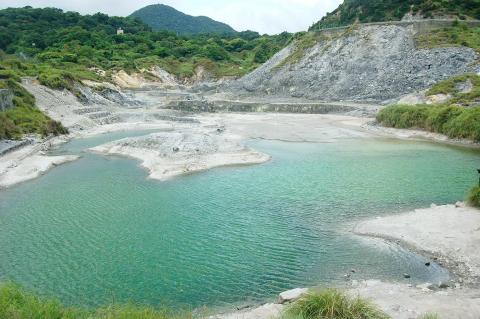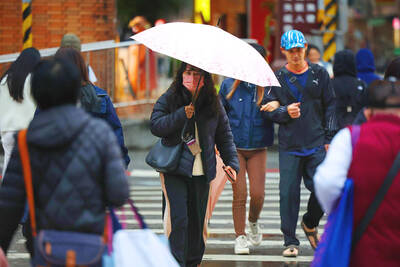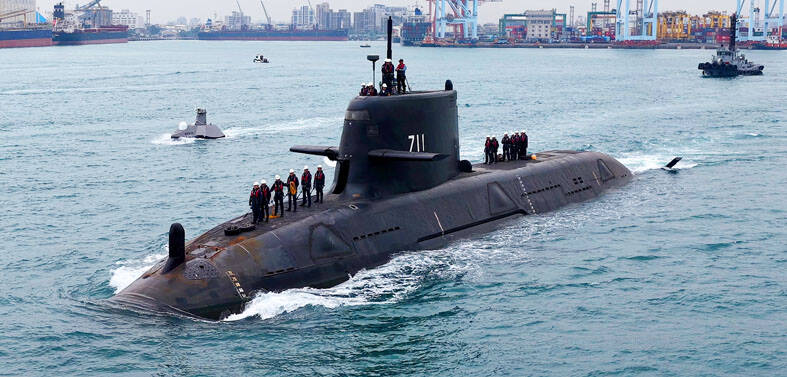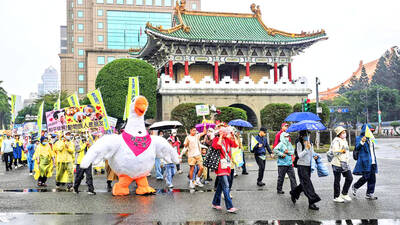Dubbed a “hot spring village,” Taipei’s Beitou District (北投) is renowned for its many hot spring hotels and resorts, mostly centered around the Xinbeitou MRT Station and Beitou Park.
The most common type of hot spring in the area is the white sulfur hot spring, which hails from the Liuhuangku Geothermal Scenic Area, a 16-hectare mountain-surrounded area southwest of the Yangmingshan National Park, followed by the blue sulfur hot springs emerging from the Thermal Valley, or Hell Valley, and iron sulfur hot springs.
According to locals, the Liuhuangku scenic area, or Sulfur Valley, was originally a mining area for sulfur minerals that were shipped mainly to China for the manufacturing of gunpowder. It was not until the Japanese colonial era that the hot springs industry flourished in the area.

Photo: Huang Chi-hao, Taipei Times
Formation of the white sulfur springs is the result of oxidation of vaporized sulfur, strata minerals on the earth’s surface, and surface water, which subsequently condenses into acidic water after making contact with cold surfaces.
The temperature of the blue sulfur hot springs from Hell Valley, which contain a wealth of sulfate minerals, can reach up to 90°C — the highest among hot springs located within the Tatun volcano group — and the spring in Beitou district is one of only two of their kind in the world.
This type of hot spring is formed by the heating of underground water by volcanic lava that mixes with surface water.

NUMBERS IMBALANCE: More than 4 million Taiwanese have visited China this year, while only about half a million Chinese have visited here Beijing has yet to respond to Taiwan’s requests for negotiation over matters related to the recovery of cross-strait tourism, the Tourism Administration said yesterday. Taiwan’s tourism authority issued the statement after Chinese-language daily the China Times reported yesterday that the government’s policy of banning group tours to China does not stop Taiwanese from visiting the country. As of October, more than 4.2 million had traveled to China this year, exceeding last year. Beijing estimated the number of Taiwanese tourists in China could reach 4.5 million this year. By contrast, only 500,000 Chinese tourists are expected in Taiwan, the report said. The report

Temperatures are forecast to drop steadily as a continental cold air mass moves across Taiwan, with some areas also likely to see heavy rainfall, the Central Weather Administration (CWA) said. From today through early tomorrow, a cold air mass would keep temperatures low across central and northern Taiwan, and the eastern half of Taiwan proper, with isolated brief showers forecast along Keelung’s north coast, Taipei and New Taipei City’s mountainous areas and eastern Taiwan, it said. Lows of 11°C to 15°C are forecast in central and northern Taiwan, Yilan County, and the outlying Kinmen and Lienchiang (Matsu) counties, and 14°C to 17°C

STEERING FAILURE: The first boat of its class is experiencing teething issues as it readies for acceptance by the navy, according to a recent story about rudder failure The Hai Kun (海鯤), the nation’s first locally built submarine, allegedly suffered a total failure of stern hydraulic systems during the second round of sea acceptance trials on June 26, and sailors were forced to manually operate the X-rudder to turn the submarine and return to port, news Web site Mirror Daily reported yesterday. The report said that tugboats following the Hai Kun assisted the submarine in avoiding collisions with other ships due to the X-rudder malfunctioning. At the time of the report, the submarine had completed its trials and was scheduled to begin diving and surfacing tests in shallow areas. The X-rudder,

DEMAND: The government should enact regulations in line with Austria and Germany to incorporate vegan nutrition into school meals, an advocate said More than 1,000 people yesterday marched in Taipei to promote veganism, calling for legislation to incorporate vegan diets into school lunches and the national net zero emissions program. Participants gathered on Ketagalan Boulevard in front of the Presidential Office Building for the march, which was organized by the Vegan Action Network (VAN). Former ambassador to Chad Chiu Chung-jen (邱仲仁), actor Yankee Yang (楊子儀) and actress Cindy Lien (連俞涵) attended the event. VAN member Marianne Chao (趙梅君) said that the campaign aimed to urge the government to promote vegan diets across schools and government agencies via legislation and national policies, which would help build